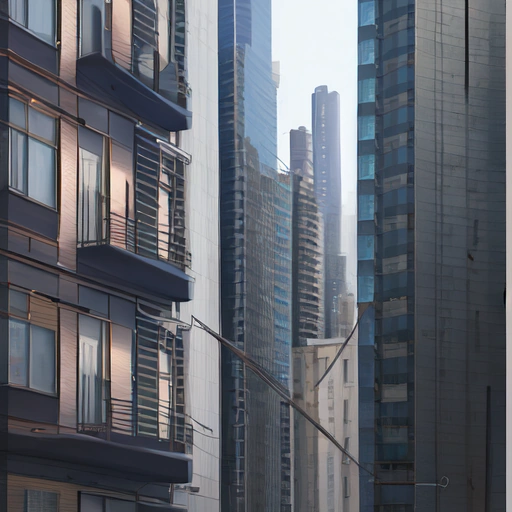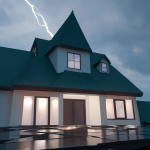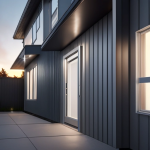Composite Siding in NYC: Pros & Cons for Urban Homes
Composite Siding in the Concrete Jungle: A New York Dilemma
In the relentless urban landscape of New York City, where historic brownstones stand shoulder-to-shoulder with gleaming modern high-rises, the choice of siding material transcends mere aesthetics; it’s a critical decision impacting a home’s durability, energy efficiency, and overall property value. In this complex environment, composite siding, an engineered blend of wood fibers and synthetic materials, has emerged as a viable contender. Its promise lies in delivering a balance of traditional appeal and modern performance, potentially offering the coveted look of natural wood without the demanding upkeep.
However, the question remains: does composite siding truly hold up against the unique challenges posed by the city’s climate, density, architectural diversity, and stringent building codes? This article delves into a comprehensive analysis of the advantages and disadvantages of composite siding for NYC homes, providing homeowners with the insights needed to make an informed choice about their home renovation projects. For New York City homeowners embarking on a home improvement project, understanding the specific benefits of composite siding in the context of the urban environment is crucial.
Unlike traditional wood, composite siding resists common urban woes like moisture damage from frequent rain and snow, insect infestations thriving in densely populated areas, and the constant threat of rot exacerbated by limited ventilation. This enhanced durability translates to reduced long-term maintenance costs, a significant advantage in a city where labor and material expenses are high. Moreover, the variety of styles and colors available in composite siding allows homeowners to maintain or enhance the aesthetic appeal of their properties, blending seamlessly with the diverse architectural landscape of NYC.
Beyond durability, composite siding offers advantages in energy efficiency, a critical factor for NYC homes battling extreme temperature fluctuations and high energy costs. The insulating properties of composite materials can contribute to reduced heating and cooling expenses, making it an attractive option for homeowners seeking to minimize their carbon footprint and lower their utility bills. Furthermore, the increasing availability of composite siding products made from recycled materials aligns with the growing emphasis on sustainable building practices in New York City. When considering exterior design options, composite siding presents a balance between environmental responsibility and long-term cost savings, a compelling combination for the discerning urban homeowner. This positions composite siding as a strong contender when evaluating the top 10 exterior siding materials for modern homes in the context of New York City’s unique needs.
Weathering the Storm: Durability and Longevity in NYC’s Climate
One of the most compelling arguments for composite siding is its enhanced resistance to moisture, insects, and rot—common adversaries in New York’s humid summers and damp winters. Unlike traditional wood siding, which can warp, crack, and decay over time, composite materials are engineered to withstand these elements. This durability translates to lower maintenance costs and a longer lifespan, a significant advantage in a city where time and resources are often stretched thin. Several manufacturers offer warranties that reflect this confidence, often spanning decades.
Specifically tailored for the demanding climate of New York City, composite siding’s resilience offers a distinct advantage over other siding materials. The freeze-thaw cycles that plague the region can cause significant damage to less durable options, leading to costly repairs and replacements. Composite siding, however, is designed to minimize expansion and contraction, reducing the risk of cracking or buckling. This makes it an ideal choice for NYC homes undergoing home renovation, providing long-term protection against the elements and preserving the aesthetic appeal of the exterior design.
When considering siding materials, New York City homeowners should prioritize this resistance to ensure lasting value. Furthermore, the composition of these siding materials often includes insect repellents and rot-resistant agents, crucial for maintaining structural integrity in the urban environment. Pests like termites and carpenter ants can wreak havoc on traditional wood siding, compromising the safety and stability of a home. Composite siding eliminates this vulnerability, offering a proactive defense against infestations. This inherent protection not only saves homeowners money on pest control services but also prevents costly structural repairs down the line.
For those undertaking home improvement projects, this feature alone can justify the investment in composite siding, especially in older NYC homes prone to pest issues. Looking at the broader market of siding materials, composite siding consistently ranks high for its long-term performance and low maintenance requirements. Compared to options like natural wood, which requires regular painting, staining, and sealing, composite siding demands minimal upkeep. A simple wash with soap and water is typically sufficient to maintain its appearance for years to come. This ease of maintenance is particularly appealing to busy New Yorkers who value their time and prefer to avoid the ongoing expenses associated with traditional siding. The initial investment in composite siding translates to significant savings in time and money over the lifespan of the product, making it a smart choice for discerning homeowners.
Aesthetic Appeal: Blending Tradition with Modernity
Composite siding offers a versatile aesthetic, adeptly mimicking the look of natural wood without demanding the intensive upkeep. This proves particularly advantageous in New York City neighborhoods governed by stringent architectural review boards or for homeowners who appreciate a classic facade but wish to avoid the common pitfalls of traditional wood maintenance. Available in a broad spectrum of colors, textures, and profiles, composite siding can be precisely tailored to harmonize with diverse architectural styles, seamlessly complementing everything from historic brownstones in Brooklyn to sleek, contemporary condos in Manhattan.
This adaptability makes it a strong contender among the top siding materials for modern homes seeking a balance between visual appeal and practicality. However, some purists argue that composite siding lacks the authentic warmth, grain patterns, and inherent character of real wood, a subjective consideration that often weighs heavily on individual preferences during a home renovation project. Furthermore, advancements in composite siding materials have significantly expanded their aesthetic range. Modern manufacturing techniques allow for deeper, more realistic wood-grain embossing and more complex color variations, blurring the lines between composite and natural wood.
For example, certain high-end composite siding products utilize multi-tonal color application to replicate the nuanced appearance of aged cedar or redwood, offering a level of visual depth previously unattainable. This technological progress directly addresses concerns about authenticity, making composite siding an increasingly attractive option for discerning NYC homeowners undertaking home improvement projects. The ability to customize the siding’s appearance also extends to trim and accent pieces, ensuring a cohesive and polished exterior design. Beyond mimicking wood, composite siding also offers unique design possibilities that natural wood cannot.
It can be molded into various shapes and profiles, including board-and-batten, shiplap, and even intricate decorative patterns. This flexibility allows homeowners to achieve a distinctive look that sets their property apart in the urban environment. Moreover, composite siding’s resistance to moisture and insects allows for bolder design choices in exterior design, such as incorporating siding closer to the ground without the worry of rot or pest damage. Ultimately, the aesthetic versatility of composite siding empowers New York City homeowners to realize their unique vision for their homes, blending seamlessly with the existing architectural landscape while adding a touch of modern sophistication.
The Bottom Line: Cost Considerations for New York Homeowners
Compared to other siding options vying for dominance in the New York City home renovation market, composite siding often occupies a strategic middle ground in terms of initial investment. While typically commanding a higher upfront price tag than vinyl siding, a popular choice for its affordability, composite generally proves less expensive than premium materials such as traditional brick, natural stone, or even high-end wood cladding. For NYC homes, this positions composite as an attractive option for homeowners seeking a balance between cost-effectiveness and enhanced durability.
The price variance depends on the specific composite blend, profile, and manufacturer, making it essential to compare quotes from multiple suppliers and installers. The true economic advantage of composite siding, particularly in the context of climate-specific exterior material selection for demanding urban environments, lies in its long-term cost-effectiveness. Unlike wood siding, which demands regular painting, sealing, and treatment against pests and moisture—constant battles in NYC’s fluctuating climate—composite siding boasts significantly reduced maintenance requirements. This translates to considerable savings over the lifespan of the siding, offsetting the initial higher cost.
Consider, for example, that a typical wood-sided home in Brooklyn might require repainting every 5-7 years at a cost of several thousand dollars each time, while composite siding could potentially last for decades with minimal upkeep, just requiring occasional cleaning. Beyond reduced maintenance, the superior insulation properties of many composite siding products contribute to long-term savings through enhanced energy efficiency. In a city like New York, where heating and cooling costs can be substantial, even a modest improvement in insulation can lead to significant reductions in monthly energy bills.
Furthermore, the resistance to rot, insects, and water damage inherent in composite siding eliminates the need for costly repairs associated with these issues, common problems for other siding materials in the humid summers and freezing winters of the Northeast. Before making a decision, homeowners should carefully evaluate the R-value (thermal resistance) of different composite siding options to maximize energy savings. To accurately assess the total cost of composite siding for your NYC home, it’s imperative to obtain multiple, detailed quotes from reputable contractors specializing in siding installation within the urban environment.
These quotes should encompass not only the cost of the siding materials themselves but also the labor costs associated with installation, removal of existing siding, any necessary preparation work, and disposal fees. Don’t hesitate to ask contractors for references and examples of their previous work with composite siding in similar New York City buildings. Understanding the full scope of the project, including potential unforeseen challenges unique to urban installations, is crucial for making an informed and financially sound decision.
Navigating the Urban Labyrinth: Installation Challenges in NYC
The dense urban environment of New York City presents unique installation challenges that homeowners must navigate when considering composite siding. Narrow streets, limited parking, and strict building codes can significantly complicate the process, potentially increasing labor costs and extending project timelines. For example, securing parking permits for construction vehicles can take weeks, and violations can result in hefty fines, adding unexpected expenses to the home renovation budget. Furthermore, older NYC homes often require extensive preparation work before siding installation can even begin.
This may involve removing old siding, repairing damaged sheathing, or addressing underlying structural issues, all of which contribute to increased costs and time. Choosing a contractor with specific experience in New York City’s unique conditions is therefore essential to avoid costly delays and ensure a quality result. Permits and inspections are also mandatory, adding another layer of complexity to the project. Navigating the Department of Buildings’ requirements demands a professional who understands the local regulations and can ensure compliance at every stage.
Beyond logistical hurdles, the very nature of NYC architecture poses challenges for siding installation. Brownstones, for instance, often feature intricate detailing and irregular surfaces that require precise cutting and fitting of composite siding materials. Modern high-rises, on the other hand, may necessitate specialized equipment and techniques to reach upper floors safely and efficiently. These factors can influence the choice of composite siding product, as some are easier to work with in complex installations than others.
For example, clapboard-style composite siding might be ideal for replicating the historic look of a brownstone, while panel-style siding could be more efficient for covering large, flat surfaces on a modern building. Ultimately, the selection process should consider both aesthetic goals and practical installation considerations. Successfully integrating composite siding into NYC homes also requires careful attention to detail regarding energy efficiency and weather resistance. Given the city’s climate, which ranges from sweltering summers to freezing winters, proper insulation and moisture management are crucial.
Siding installation must include a robust weather barrier to protect against water infiltration, preventing mold growth and structural damage. Moreover, selecting composite siding with a high R-value (a measure of thermal resistance) can significantly reduce energy consumption, leading to lower heating and cooling bills. According to a recent study by the NYC Department of Energy, homes with properly insulated siding can save up to 20% on energy costs annually. Therefore, investing in high-quality composite siding and professional installation is not only an aesthetic upgrade but also a smart financial decision for New York City homeowners.
Green Credentials: Energy Efficiency and Environmental Impact
Composite siding generally boasts better insulation properties than traditional wood, contributing to improved energy efficiency and lower heating and cooling costs. This is a significant benefit in New York City, where energy prices are high and temperature fluctuations can be extreme. For NYC homes, selecting siding materials with strong insulation is paramount to reducing energy consumption and maintaining comfortable indoor temperatures year-round. Some composite siding products are also made from recycled materials, making them a more environmentally friendly choice.
However, it’s important to consider the manufacturing process and the overall carbon footprint of the material when evaluating its environmental impact. Beyond just insulation, the composition of modern composite siding often incorporates innovative technologies designed to enhance its green credentials. Many manufacturers are now using fly ash, a byproduct of coal combustion, or recycled polymers in their composite blends, diverting these materials from landfills and reducing the demand for virgin resources. When considering composite siding for your home renovation, look for products certified by organizations like the Forest Stewardship Council (FSC) or those with Environmental Product Declarations (EPDs) to gain a clearer understanding of their environmental performance.
These certifications provide transparency regarding the material’s sourcing, manufacturing, and overall lifecycle impact. Furthermore, the longevity of composite siding plays a crucial role in its overall environmental footprint. Unlike some siding materials that require frequent replacement, high-quality composite siding can last for decades with minimal maintenance. This extended lifespan reduces the need for new materials, lowers waste generation, and minimizes the environmental impact associated with siding installation and disposal. For homeowners in the urban environment of New York City, choosing durable and long-lasting siding materials is not only a cost-effective decision but also a responsible choice for minimizing their environmental impact. By carefully evaluating the composition, manufacturing process, and lifespan of composite siding, homeowners can make informed decisions that align with their sustainability goals and contribute to a greener future for their NYC homes.
The Verdict: Is Composite Siding Right for Your New York Home?
Composite siding offers a compelling blend of durability, aesthetics, and energy efficiency, making it a viable option for New York City homeowners seeking a low-maintenance and long-lasting siding solution. However, it’s crucial to weigh the pros and cons carefully, considering factors such as cost, installation challenges specific to the urban environment, and personal aesthetic preferences. By conducting thorough research, obtaining multiple quotes from licensed and insured contractors experienced in NYC home renovation projects, and carefully evaluating the long-term value proposition, homeowners can make an informed decision that enhances their property’s value and protects it from the rigors of the urban environment.
When considering composite siding for NYC homes, it’s essential to delve into the specifics of available products. For instance, some composite siding materials boast superior resistance to the freeze-thaw cycles common in New York winters, preventing cracking and warping that can plague less resilient options. Others offer enhanced UV protection, crucial for maintaining color vibrancy in sun-exposed areas. Leading manufacturers are continuously innovating, incorporating new technologies like advanced polymer blends and improved wood fiber treatments to further enhance durability and weather resistance.
Understanding these nuances is key to selecting the right composite siding for your specific needs and microclimate within the city. Moreover, the choice of siding materials should align with the architectural style of your home and the surrounding neighborhood. In historic districts, homeowners may opt for composite siding that mimics the look of traditional wood clapboard, preserving the character of the area while enjoying the benefits of modern materials. In contrast, contemporary homes might benefit from sleek, modern composite siding profiles that complement their clean lines and minimalist design.
The versatility of composite siding allows for a wide range of aesthetic possibilities, making it a suitable choice for diverse architectural styles found throughout New York City. Ultimately, the best composite siding solution will not only protect your home but also enhance its curb appeal and contribute to the overall aesthetic harmony of your neighborhood. Finally, don’t underestimate the importance of proper siding installation. In a densely populated city like New York, navigating building codes, obtaining necessary permits, and coordinating with contractors can be complex.
Hiring a contractor with extensive experience in siding installation within NYC is crucial to ensure a smooth and successful project. A skilled installer will be familiar with local regulations, understand the unique challenges of working in tight spaces, and possess the expertise to properly flash and seal the siding to prevent moisture intrusion. Investing in professional siding installation is an investment in the long-term performance and durability of your composite siding, safeguarding your home from the elements for years to come.


